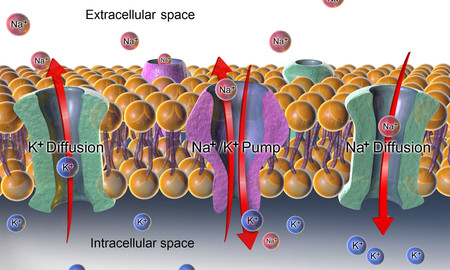The SAR sensor does not rest. It has the responsibility of perceiving the proximity of our body, but it does not come into action only when we bring our smartphone close to our face to avoid touching the touch screen without intending to; is also responsible for keep electromagnetic radiation under control emitted by our mobile phone. No more no less.
When we consult the specifications of our terminal and verify that in the section dedicated to its provision of sensors, the manufacturer tells us about the proximity sensor, actually is mentioning the SAR sensor. But it would be unfair to accept that all it does is identify that our face is close to the screen. Without it, our mobiles would not be able to measure the radiation they emit at a given moment in order to prevent it from crossing a maximum threshold. And possibly they would not exceed the requirements imposed by current regulations on the emission of electromagnetic radiation.
We start at the beginning: what does SAR mean?
The acronym SAR comes from the English expression Specific Absorption Rate, which we can translate as specific absorption rate or index. This value reflects the power absorbed per unit mass of body tissue, its average can be calculated in the whole body or in some parts of it, and is expressed in watts per kilogram (W / kg). This definition is rigorous, but it is also a bit complicated, so here is a simpler one: this parameter measures how much radio frequency energy the human body absorbs when it is exposed to an electromagnetic field like the one emitted by our mobile phones.
The SAR parameter measures how much radio frequency energy the human body absorbs when it is exposed to an electromagnetic field such as that emitted by our mobile phones.
According to the Official State Gazette (BOE), whole-body SAR is a widely accepted measure for relating adverse thermal effects to exposure to radioelectric emissions, but local SAR values are also necessary to evaluate and limit overexposure to energy in small parts of the body. It is interesting that it sounds to us and have an approximate notion of what this parameter identifies so that those who want to investigate more can take a look at what the current legislation says today.
On the other hand, it is also interesting that we know that the Spanish regulations include the recommendations made by the European UnionTherefore, the legislation in Spain should not be very different from that of other neighboring countries. This explains that the smartphones that we can acquire in the states that make up the European Union are identical if we stick to their radio transmission capacity, but they may be different in this context from the terminals of the same brand and model that are marketed in countries such as China.
This is how the SAR sensor of our smartphone works
Our body has the peculiar ability to generate electricity, an ability that is essential for our life is possible. A direct consequence of this phenomenon is that our body is surrounded by a very low intensity electric field, which is nothing more than a region of space that surrounds us in which, if an electric charge enters, it will experience an electric force caused by the presence of one or more additional electrical charges. The definition of electric field, as we have just seen, is a bit convoluted, but it is easy to guess what we are talking about if we think about how the magnetic field generated by a magnet manages to induce a force capable of acting on a metallic object with magnetic properties placed in its vicinity.
As I mentioned, the electric field that surrounds our body It is very weak, but the progress that microelectronics has experienced in recent years has caused us to be able to design and manufacture sensors that have the necessary sensitivity to perceive them. These are the SAR sensors. Normally the integrated circuits that contain them house more than one sensor because the combination of several allows to increase their sensitivity. But this is not all that we can find inside these chips. And it is that the most advanced models also usually incorporate the necessary logic to accurately identify if the body next to the sensor is a human being or an inanimate object.

Nowadays we don’t have to go to great lengths to find a device equipped with a SAR sensor. They live inside our smartphones, but also in tablets, smart watches, and many laptops. In any case, the most curious thing is the strategy they use to read the subtlest electric fields. And what they really do is permanently monitor the electric field that surrounds them with the purpose of identifying changes of intensity in it. From there, the “intelligent” logic that I have spoken about in the previous paragraph takes the reins to determine if the disturbance of the electric field that we are measuring has been caused by the proximity of our body or another object.
SAR sensors are capable of measuring the weak electric field generated by our body
As we have just seen, this strategy is relatively straightforward, but it poses a challenge: how does the SAR sensor know that the electric field it is measuring is not the one generated by the mobile phone itself? Because, as we can guess, the presence of electronic components inside causes originate its own electric field. The SAR sensor does not know whether or not it is measuring the electric field of the phone, but the logic that accompanies it has been trained to characterize it and pay attention to the interactions of the field that surrounds the sensor with other electric fields, which is what interests us .

An interesting note: during the start-up of the mobile phone its electric field fluctuates, so it is necessary to ignore the reading of the SAR sensor for a few seconds and wait until the electric field stabilizes. Otherwise the logic that works in tandem with the sensor could interpret that there is an object nearby and turn off the screen. However, as I mentioned in the first paragraphs of the article, the information collected by the SAR sensor is not only used to perceive our proximity and turn off the screen; it is also used for audit radiation in real time non-ionizing radio frequency emitted by the phone, so that if at any time it exceeds a predetermined threshold value, the logic of the mobile triggers the actions necessary to reduce it.
Bioelectricity: how our body generates it and what it is for
The electricity used by our body to carry out biological processes known as bioelectricity, and it is crucial for our organs to carry out their function correctly. Our muscles and our hearts use it to produce movement; our neurons to issue the orders that govern the functioning of our body and so that we can see, hear, think and store memories, among many other functions; and our eyes use it to collect light stimuli and send them to the brain, which is in charge of processing them. These are just a few simple examples that can help us intuit with some precision how important bioelectricity is to make life possible as we know it. Not only that of animals; also that of plants.
The electricity used by our body to carry out biological processes is known as bioelectricity
Our central nervous system, which is made up of the brain and the spinal cord, is responsible for coordinating the proper functioning of the organs and for receiving stimuli from outside, processing them and issuing the appropriate orders in the form of electrical signals. On the other hand, the peripheral nervous system is essentially made up of nerves that have a double function: to transport the electrical signals emitted by the central nervous system to the organs and structures that must carry out their orders, and also to transport them to the central nervous system. the sensory stimuli collected by the organs that are responsible for collecting them, such as our eyes or ears. Without eleectricity none of this would be possible.

But how does our body manage to generate this bioelectricity? Those responsible are the cells, and they get it thanks to a protein that is present in all the cells of our body called sodium-potassium pump. Its function is to keep the ions inside and outside the cell in balance, which are nothing other than atoms or molecules that do not have the same number of electrons and protons, which causes their global electrical charge to be non-neutral. If they have more electrons than protons they acquire a negative charge and are called anions, and if they have more protons than electrons they acquire a positive charge and are called cations. When an atom with a neutral charge acquires one or more electrons, it ionizes, which means that it becomes an anion. And if you lose them, for whatever reason, it also ionizes, but this time it becomes a cation. What is really interesting is that this process causes the atom or molecule to acquire an electric charge, and this charge is the true germ of bioelectricity.

 This recreation illustrates how ion channels allow the transport of sodium and potassium ions through the cell membrane to generate the electrochemical potential that causes the appearance of the electrical signal.
This recreation illustrates how ion channels allow the transport of sodium and potassium ions through the cell membrane to generate the electrochemical potential that causes the appearance of the electrical signal.
Let’s get back to paying attention to our cells. The sodium-potassium pump that we have talked about in the previous paragraph is responsible for transporting sodium and potassium ions through the cell membrane, thus altering its electrical balance. Ions are capable of crossing the cell membrane using conduits called ion channels, which can be of various types and which allow the cell to interact with its environment by emitting signals. Although it is an oversimplification, we can imagine that each ion channel allows the cell to send a signal that encodes a specific message in response to a specific stimulus.
And finally, we reach the culminating moment: when the cell needs to emit an electrical signal to send a message, the sodium-potassium pump carries out the exchange of ions in and out of the cell membrane. This mechanism alters your concentration and gives rise to an electrochemical potential, which is not very different from the potential difference that makes possible the transport of charges between two points with different electric potential in a conventional electric circuit. This is what we know as an electric current. The flow of electrons will cease when the electric potential of the two points equalizes. The interesting thing is that, precisely, the imbalance of the electrical charge inside and outside the cell generates a potential difference that causes the production of a very low voltage “spark”. Here we have it. This is the moment in which our cells generate bioelectricity without which our life would not be possible.
Cover image | cottonbro
Images | Sound On | Bruce blaus

